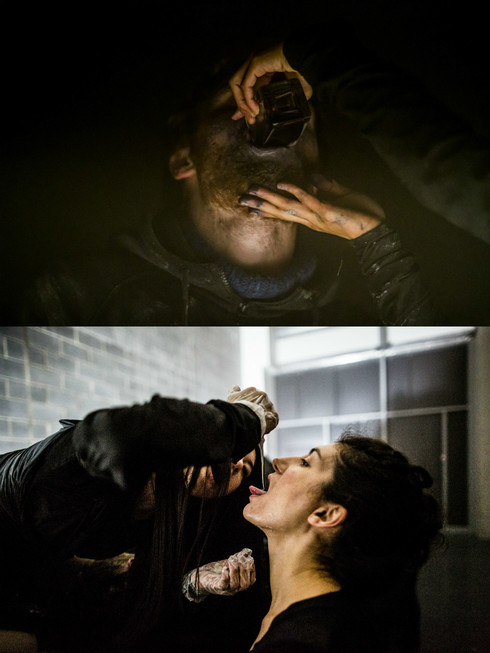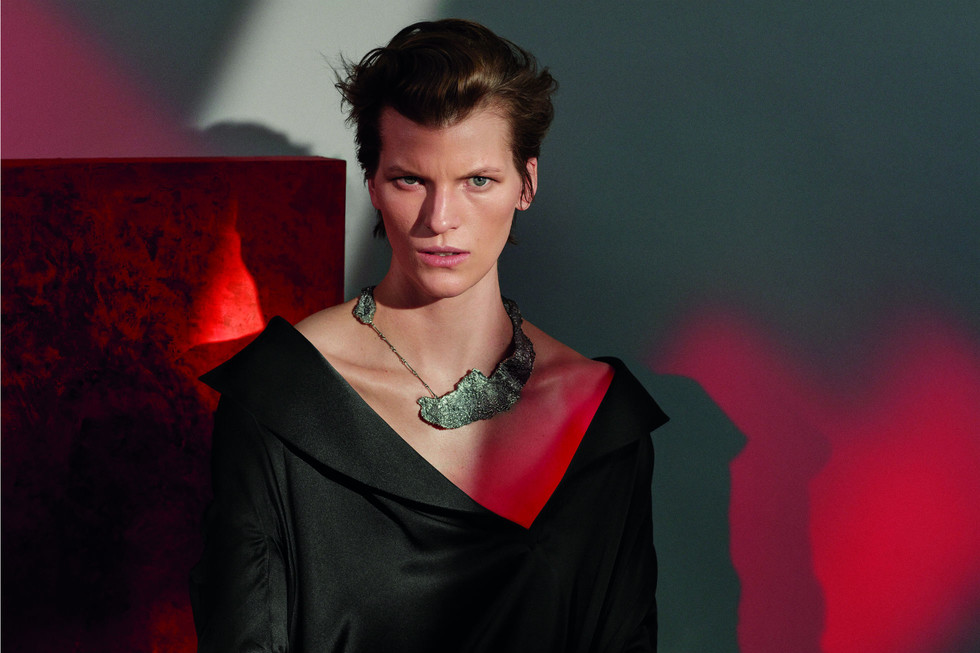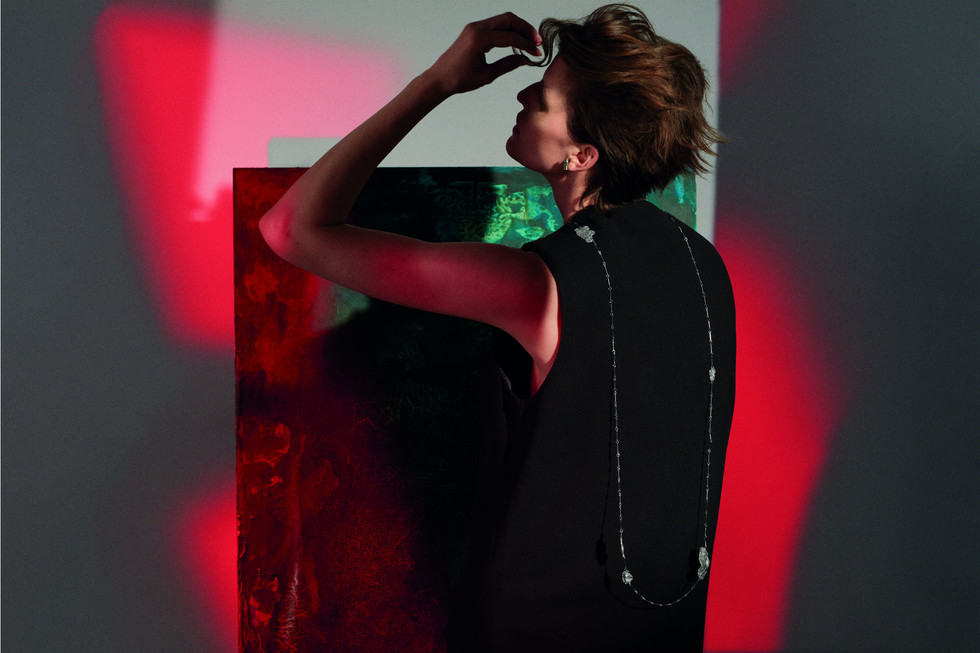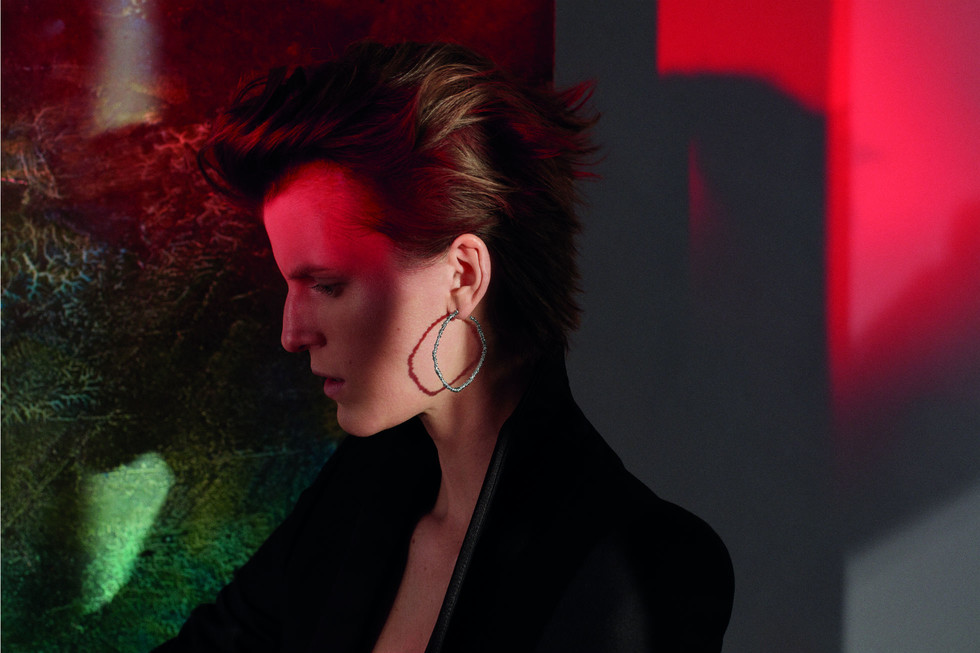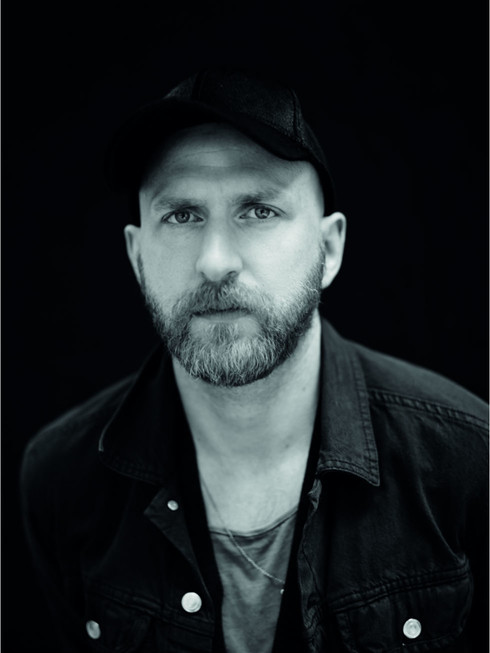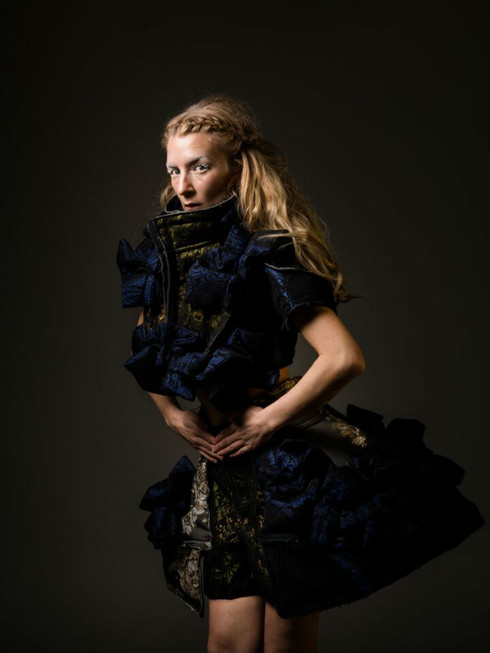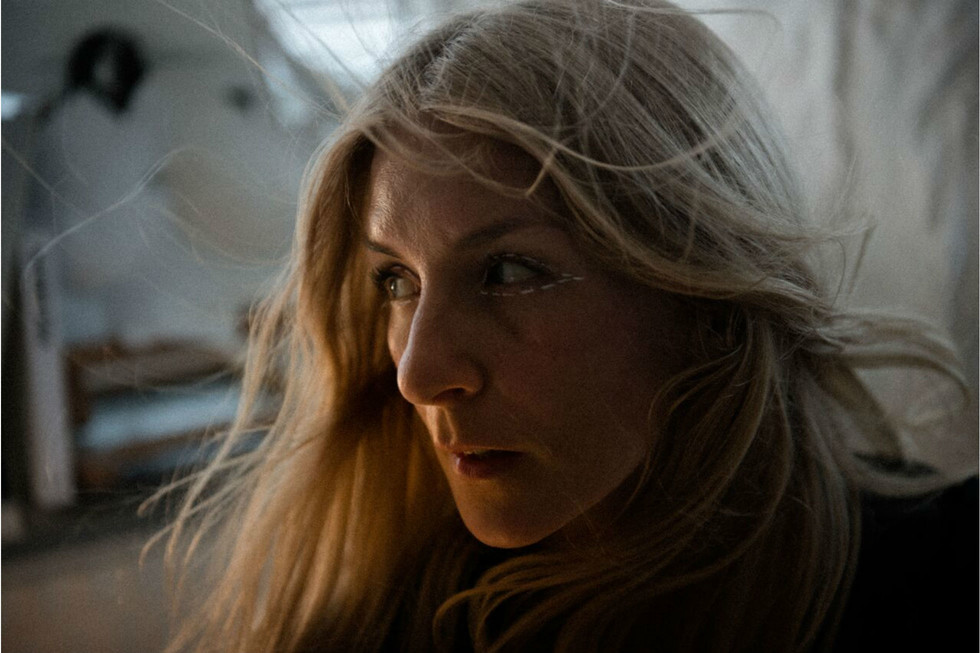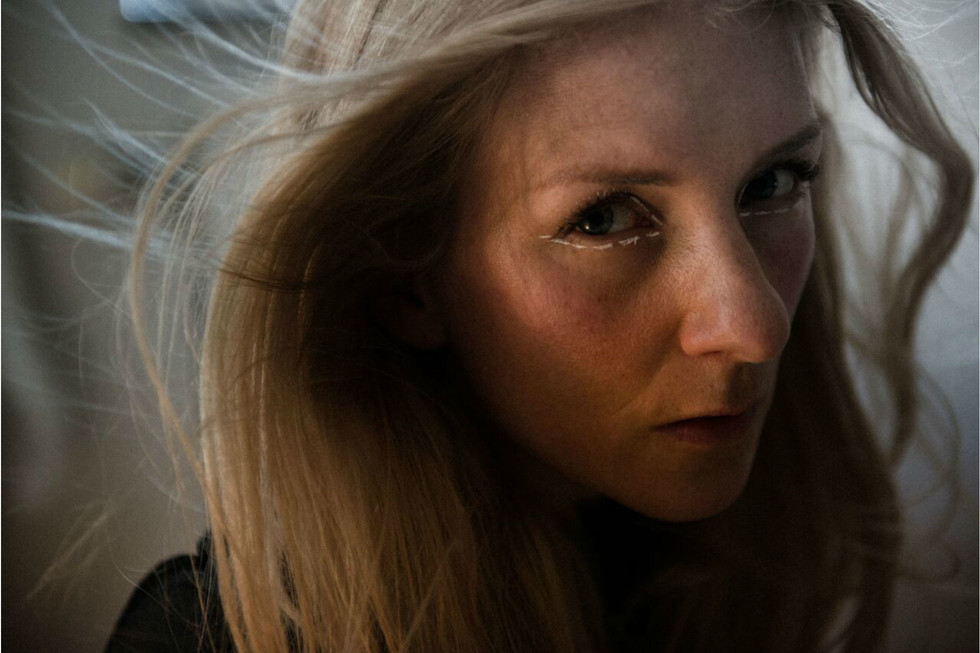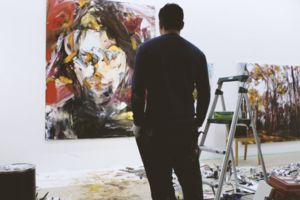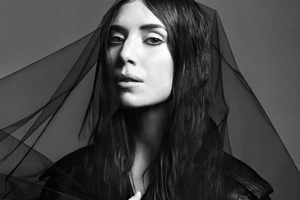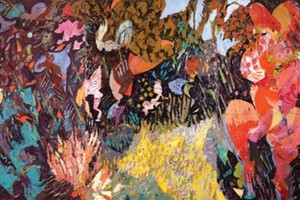Ionnalee has been exploring her music artist path from Jonna Lee to Iamamiwhoami, creating a number of mystically fascinating audiovisuals, where Norse mythology and social issues turn into a video story with its own narrative and vocal character. Today, as ionnalee, she has gone back, where it all once started and created a new solo music album ‘Everyone Afraid to Be Forgotten’. The Swedish female artist’s predilection for nature and music conceives a peculiar world of sustainability and creativity, where the audience, through the music, lyrics and visuals are invited to participate and help shaping the final ‘product’ by being a part of it.
Ionnalee’s collaboration with the luxury brand Comme des Garçons with its urban aesthetics, enhanced with the authentic synthesis of Kabuki’s colourful drama and the koto’s pacific sounds, seems to be natural, making the artist and the clothes build a spiritual integrity.
The existential belief of ionnalee is a philosophy, where no one is forgotten and everyone is included. The magic is here and you just have to open your eyes and see the nature, prick up your ears and hear the universe. Become like ionnalee, a searcher who explores!
I have watched some chapters from Iamamiwhoami’s albums ‘Bounty’, ‘Kin’ and ‘Blue’ and I could see the nature as a least common multiple. There are beautiful landscapes with mountains and meadows in your visuals. Where have you filmed those? How did you find/choose those places?
These three series you mention were made under a period of 5 years. So there is a lot of different locations filmed in, depending on what scenes are filmed, they are chosen from what the idea is for the scene in particular. We have a clear image of it beforehand, it is drawn and storyboarded and then we find the best possible physical counterpart of the idea. Most of my/our releases are filmed in Scandinavia.
Some videos have amazing underwater moments with you in them. Could you describe your experience of the underwater filmmaking? Have you received any special training prior to that?
Thank you. For BLUE in particular that was made entirely around water, there was a lot of holding breath. And also for some of other series there have been challenging under water scenes, but BLUE took it to a whole new level. I love free swimming, snorkelling and moving under water, so the practise I have is from being comfortable in water since childhood. However, it still was a challenge, especially in HUNTING FOR PEARLS, where the underwater pressure was an issue in my ears weren’t doing so well. During the 1.5 years we spent on making BLUE we filmed underwater in different kinds of water environments. Tropical oceans, freezing lakes and it was all amazing.
Your visuals are very metaphorical and mythological with a lot of black, white and grey hues. I understand that you use nature and its dwellers for the metaphorical part. Where does the mythological part come from? Are you referring to Celtic mythology or Scandinavian sagas?
There are referrals to Norse folklore in my work. I was brought up with it and it is in my heritage.
You represent a strong woman in your visuals, who is exposed to the power of nature and in a certain way is merged with the latter. Where does that image of strong woman come from?
Taking control over my own work and life has been a big process throughout my career and that is the image I think you are referring to in my visuals.
In one interview you mentioned that you never use real fur in your videos. Are you a sustainable artist? What does it mean for you to be a sustainable artist? Do you also try to organise your working process in a sustainable way?
I feel part of nature and do not want to be separated from it like we are in the cities we build as protection and segregation from it. I try to be sustainable and responsible in what I wear, how I consume, what I eat. That humbleness before ones place in nature is important not to lose. Many see nature as pretty backdrop and that is scary.
To know what prints we leave and aim to make the work stand with time and not encourage a lifestyle of quick consumption is a good start in being sustainable. My label TWIMC, which I use to produce and release my work, do our best to manufacture and release in an environmentally friendly way, like only producing unisex organic fairwear, offering ways to support great organisations like ‘Mission Blue’, ‘One Tree Planted’, and we have recently taken in two homeless dogs.
Are you a boss or a chief in the process of creating your visuals? Is it the same for both the production of Iamamiwhoami and your first solo music album ‘Everyone Afraid to Be Forgotten’?
Well, I will always need to be the boss of my own work. For ‘Bounty’ and ‘Kin’ I was the executive producer and for BLUE and EABF I am also co-director and editor. For TWIMC I am the visual director for all releases.
You consider “Everyone Afraid to Be Forgotten” to be ‘rather its own separate organism, combining a dramatic plotline, music and art house cinematography with an avant-garde fashion slant.’ Is the album a creative and independent endeavour to look for your personal identity as ionnalee - outside iamamiwhoami - or is it more like an independent commercial product of your skills gained in the industry through the years?
You could see it as: before iamamiwhoami I made two solo albums (Jonna Lee). Iamamiwhoami, which is a duo that includes my long-time collaborator Claes Björklund, began in 2009 and I then put all my solo work on hold for undecided time and went through a major creative metamorphosis. Now 10 years later, ionnalee is where I reconnect with my solo work and release that album that I began making many times since 2009 when iamamiwhoami was born.
Quoting your text from the song ‘Goods’, ‘Change is always given to decide just who it’s for’, I would like to ask you about your first solo album - who is it for?
It is ‘change is always given to the searchers who explore.’ Cannot trust them lyric pages.
It is said that you’re reflecting on your own perspectives, leaving the audience a space for personal experience. Is it a monologue you have, while giving the audience their own space or are you establishing a dialogue by inviting into your world - the world of audio visual artist ionnalee?
Yes. As an independent artist the dialogue with the audience is direct. There is room for raising questions and open up for interactions. They are invited in through communication through the music, lyrics and visuals and they help shape the work by being invested and vocal. It does not mean they shape it their direction. There are many layers to the online world and you can browse it on the surface or you can dive in and be part of it and many of my followers are.
Who are you influenced by? Kate Bush? The Knife? Cocteau Twins? DAF? Front 242? Fever Ray?
Kate Bush and Karin are both incredible artists in different ways. They are also both people I get compared to a lot because we are all women with strong vocal character but our music and visuals are not very similar- I heard Kate Bush very late in life for the first time and I loved ‘Running Up that Hill’ in particular. Voice and production together.
As I see it, there are the conscience influences that you willingly consumed. For me that is Kraftwerk, Cocteau Twins, Depeche Mode, Christopher Nolan, Air, Vangelis, Madonna, David Lynch, Portishead, Sigur Ros and many more. There are also newer creators I enjoy like Blood Orange, Arca, Denis Villeneuve, Chromatics, Four Tet, Björk, Todd Terje, Disasterpeace and Mozart.
Then there are the influences that you were force-fed socially through your upbringing. My childhood offered my parents excellent-taste vinyl collection of Chaka Khan, Pet Shop Boys, Madonna, Tom Petty. And then what was on radio at the time, Snap! Two Unlimited and Backstreet Boys. I really liked Marie Fredriksson’s voice as a kid. I wished for a NKOTB’s vinyl for my eleventh birthday but got Roxette’s ‘Tourism’ instead because the local record store did not have NKOTB. That ended up being a record I sang to for the next year because I learned to love it. ‘Queen of Rain’ is a classic.
Have you in any way been engaged in the production of Fever Ray’s latest album “Plunge”? Have you inspired each other?
I have not been part of it but I think it is great.
You have collaborated with Comme des Garçons. Have you had any other collaborations with other fashion brands in your visuals? Any plans to do it in future?
No plans beyond CDG. Adrian Joffe and I were introduced through the release of BLUE in 2014 and we did a photo series together for Vogue Italia. We began discussing how to collaborate and eventually created an alliance for EVERYONE AFRAID TO BE FORGOTTEN. COMME des GARÇONS (‘like boys’) is a daring, equal and strong voice in the world of fashion, much what I aim to be for the music scene.
Starting from ‘Bounty’, you often wear different jumpsuits in your visuals. Could you explain the choice of garments? Is it an attempt to create a discourse about female body culture in the entertainment industry?
There is always a reason for what I wear that is based in the story we are telling. As an example, for ‘John’ in Bounty I wear a wash cloth jumpsuit for protection in the bedroom where the video takes place in. However and whatever I wear, there is a purpose for it coming from the storytelling.
There is a black cube appearing in a visual from ‘Blue’ and also in ‘Goods’ from ‘Kin’, what feels very Tarkovskij and his ‘no-go-zone’. What is the cube referring to?
‘Kin’ was the second audiovisual we released in 2012, and it was also the first release to receive a physical edition. The black cube in ‘Kin’ represents our ‘product’ that we released. And watching ‘Kin’ you get to come inside the process of our making.
Please reveal the secret of your beautiful long lashes that have appeared in many videos, sometimes totally white and sometimes blonde. What do they symbolise? Are you wearing those outside the creative space?
It is bringing me a step closer to the inner animal being.
You believe in evolution talking abstraction in previous interviews. Do you see any parallels between what you do today and what the pioneer of abstraction Hilma af Klint did a century ago - translating music into visual forms?
She grew up in a time when women had much less voice than now and where art schools had only just begun accepting female students. It is very inspiring how she managed to have such a clear artistic point of view. I can see she had a passion that I share, where the arena you work does not appreciate dissipations. That is not conductive to exploring, so you have to go your own way. She was a pioneer and made some incredible pieces of art that were not fully appreciated until after her passing.
Do you consider yourself to be an art or a fashion influencer? Maybe both?
It is hard to answer. I am not the receiver you know, but I can see that my work creates ripples that at least subconsciously makes an impact on people.
You have lived in London for a while and your favourite street there is Portobello Road with its Victorian terrace houses. Could you say what you love about that street?
It is a calm but a living street with such a mixed crowd of regulars, artists and tourists. I used to live close by. For some reason I am drawn to the places where there are lots of tourists. Just like with airports, people are on the way, often enjoying themselves with an open mind. The best thing about London is that it is so multicultural and alive.


